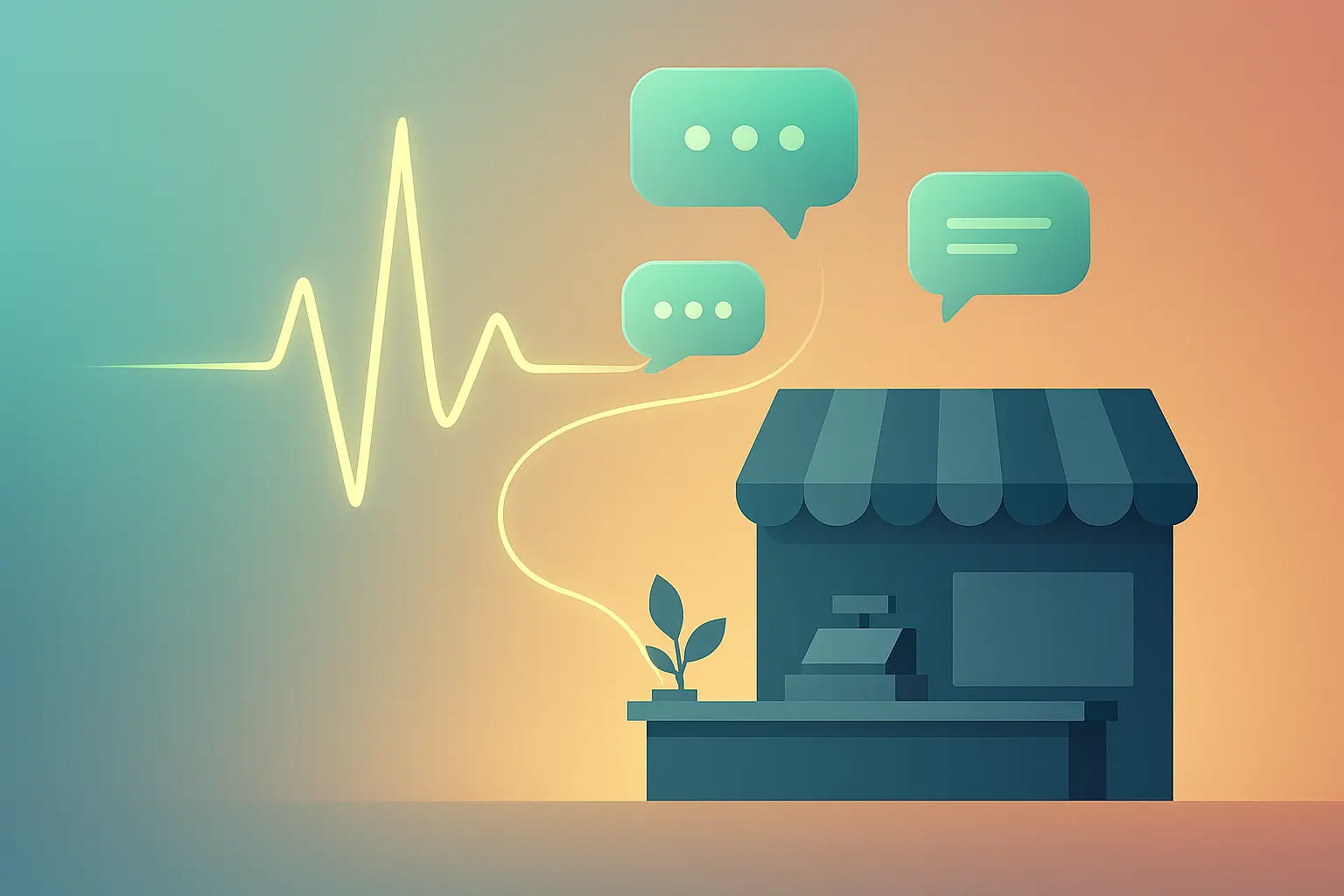Customer Engagement Platform: Features, Benefits & Examples
- April 15, 2021
- 14 mins read
- Listen

Connecting with customers in meaningful ways is a big challenge for a business. Modern businesses are turning to Customer Engagement Platforms (CEPs) to revolutionize how they engage with their audience. These platforms offer a range of tools and capabilities designed to facilitate personalized and multichannel interactions that create deeper connections and drive meaningful outcomes.
In this article, let us go deeper to learn more about what constitutes a customer engagement software platform and the various types of customer engagement tools based on their use cases.
What is a Customer Engagement Platform (CEP)?
A customer engagement platform is software that helps businesses acquire, engage, and serve customers across all cocmmunication channels under one solution. Having all conversations in one inbox helps you to understand the customer journey and get better insights to help agents make better decisions.
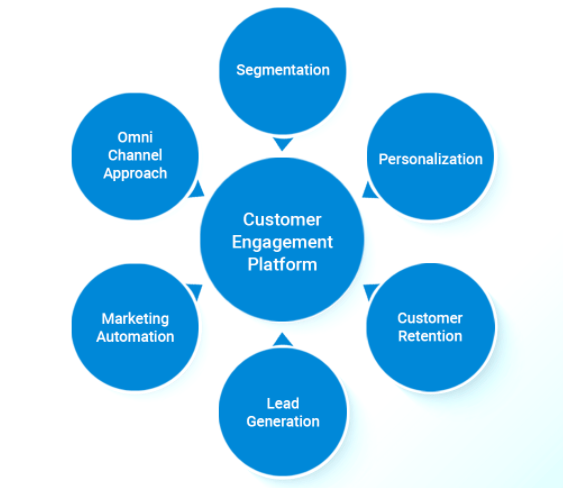
.
With the right customer engagement hub and software in place, you can build long-lasting customer relationships that can increase customer lifetime value (CLTV), sales conversions, as well as retention.
The core elements of customer engagement are:
- Omnichannel communication – Engage customers across their preferred channels in real-time and deliver a consistent experience.
- Live engagement – Use visual tools like video chat and co-browsing to collaborate with customers in real-time and drive personalized engagement.
- Customer engagement automation – Select a platform that offers powerful features like automated triggers, chatbots, advanced routing, etc. to engage customers in real-time.
- Third-party integrations – Integrate your favorite tools with the engagement platform and manage conversations effectively from a single dashboard.
How a Customer Engagement Platform Works?
If you want to know the entire procedure, just think of a bustling hub where streams of data flow in from all directions. And, converging into a unified nexus of customer insights. This is the heart of a Customer Engagement Platform (CEP), where every interaction website visits to social media interactions are meticulously collected and integrated.
With the help of advanced analytics, it transforms this wealth of data into actionable intelligence, segmenting customers into distinct groups based on shared traits and behaviors. You cannot deny that automation lends efficiency. It frees up valuable time while ensuring timely and relevant communications.
Behind the scenes, the platform’s analytical prowess discloses customer behavior and plays a crucial role in making strategic decisions and fine-tuning engagement strategies. As feedback flows back into the system, businesses adapt and evolve. You can continually nurture relationships and foster lasting loyalty.
Also, it serves as both architect and conductor and harmonizes the symphony of customer engagement with precision and finesse.
Difference Between a CRM and a Customer Engagement Platform
Both Customer Relationship Management (CRM) systems and Customer Engagement Platforms (CEPs) share a common goal. They enhance customer interactions, but they differ significantly in scope and functionality. A CRM system primarily manages customer data, tracks interactions, and facilitates sales and service processes.
It serves as a repository for customer information. Also, it enables businesses to streamline their sales pipelines, manage leads, and track customer communications.
On the other hand, a Customer Engagement Platform goes beyond data management. It incorporates advanced analytics, multichannel engagement capabilities, and personalized interactions. It orchestrates targeted marketing campaigns, automates customer communications, and analyzes customer behavior to optimize engagement strategies.
Unlike a CRM, which primarily serves sales and service teams, a CEP encompasses marketing, sales, and customer service functions. It provides a holistic approach to customer engagement across the entire customer lifecycle. In essence, while
Finally, a CRM is focused on managing customer relationships and transactions, in contrast, a CEP is geared toward cultivating meaningful engagements and long-term customer loyalty.
Key Benefits of Customer Engagement Platform
A good customer engagement platform should provide capabilities to streamline your communication with your clients and deliver them an unforgettable experience.
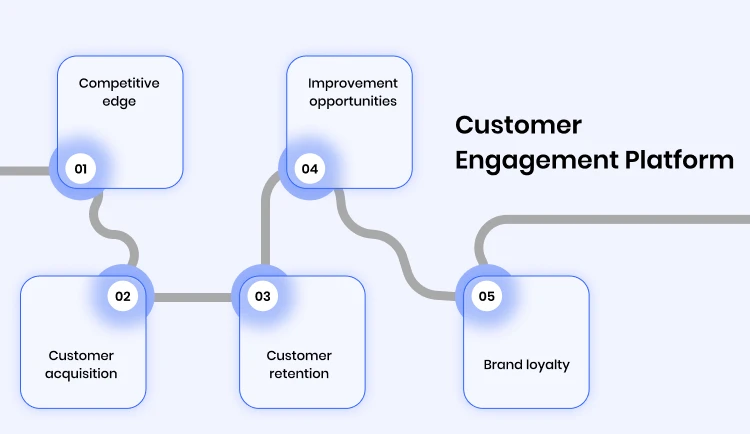
However, the important use cases of customer engagements are discussed below.
1. Increase Website Engagement
Websites are a key source of customer engagement and lead generation. Implementing appealing web design and engagement ideas helps constructively engage users at multiple touchpoints to increase website engagement.
2. Real-time Customer Engagement
Engaging customers at the right moment when they are looking for it with the help of advanced digital engagement tools like live chat, co-browsing, and video chat delivers a better conversational support experience.
3. Scale Customer Service
An effective customer engagement platform helps to scale customer service as per the requirement to deliver an excellent customer service experience.
4. Automate Lead Generation
Leveraging AI chatbots helps businesses automate lead qualification by asking preset questionnaires to website visitors. It helps to close sales instantly, which increases sales funnel velocity.
Must-Have Features for Customer Engagement Platform
Investing in a customer engagement technology or platform allows businesses to significantly improve the experiences they offer to their customers through digitalization and automation via a variety of communication channels.
Self-service portals and digital communication channels are the key driving forces for retaining your customer base and overall business growth.
Now we know why you should have a CEP, let us go through the key features narrowed down, which include digital customer service channels, a self-service portal, and a knowledge base.
1. Live Chat
Customer concerns not being addressed fast is one of the crucial reasons why clients abandon online transactions.
92% of customers feel satisfied when they choose live chat to connect with businesses, unlike reactive channels such as phone or email.
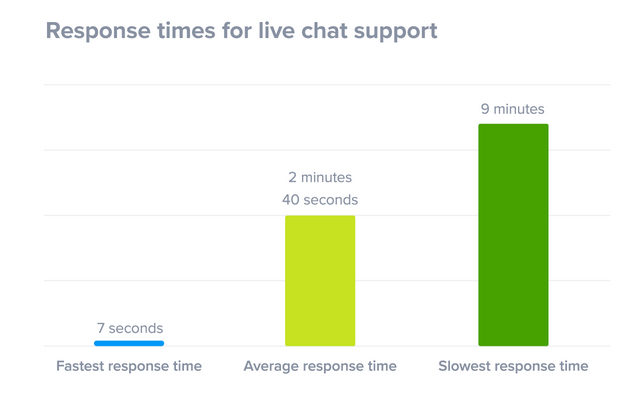
As response time plays a vital component of a good customer service experience, live chat fulfills it by having their issues resolved quickly.
Live chat is the most preferred software by businesses to deliver real-time responses to customers. It is a complete customer service toolkit that includes live engagement tools like co-browsing and video chat that deliver an interactive support experience.
2. Chatbot
An AI-enabled customer engagement software fulfills client’s expectations of getting real-time responses.
Chatbots can engage with your customers with immediate responses and increase customer satisfaction, which makes them happy to retain your brand.
Using a chatbot, you can easily understand how to measure customer engagement online and cater to engaged customers across their journey with your brand.
How do AI bots improve customer engagement?
- Chatbots engage customers 24×7 when the support team is busy or not available.
- AI bots can easily engage customers to handle information-based questions and reduce support tickets.
- Bots are easily scalable during peak hours to engage customers and deliver a better customer experience.
Emirates Vacations is the best chatbot example for boosting customer engagement. They built a chatbot within its display ads and engagement rates have risen 87% since deployment.
3. Video Chat
33% of customers are most frustrated by having to wait on hold and by having to repeat themselves to multiple support reps.
Visual engagement tools are being widely adopted by businesses to increase customer engagement. Engaging clients with video chat helps customers through tricky situations in real-time, unlike reactive channels.
Live video chat is a proactive support channel that allows:
- You identify issues faster in the first go and provide effective responses.
- Significantly reduce the number of touchpoints by delivering contextual solutions.
- Engage customers with personal conversations and build trust.
4. Knowledge Base
A knowledge base is one of the most powerful tools when it comes to capturing, managing, and propagating knowledge across an organization.
The reasons to employ such a solution are as numerous as the benefits of knowledge sharing themselves, especially for businesses that are always eager to learn more, keep improving, and provide better customer service.
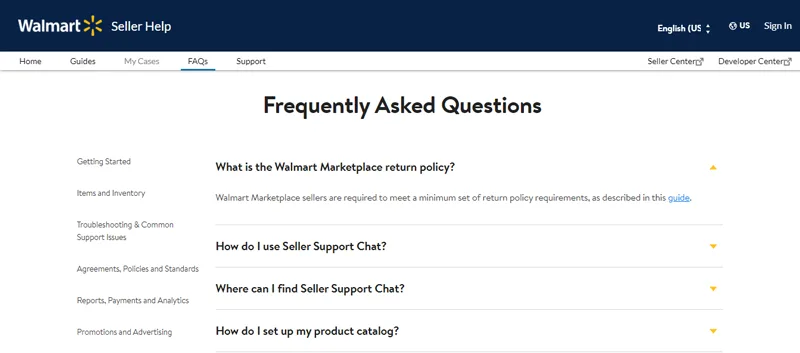
A customer engagement platform can easily track the links when customers land on your knowledge base. You can also see whether people have their questions answered when they visit them and keep track of the resources you have already shared.
5. Social Media Channels
Social media platforms can help with customer engagement in several ways. In addition to effective engagement and communication, social media also makes it easier to market your brand.
Here is how social media platforms can help to boost engagement.
- Build rapport with followers: With social channels, you can build a rapport with audiences and connect with your audience on a more personal level.
- Make your followers feel special: Social media is a great way to make your audience feel special by offering special deals and promotions. It helps to win more followers and retain the existing ones.
- Engage with audiences: By ensuring your posts are relevant, you can get a positive reaction from your audience and in turn, engage with them. It helps to improve your brand image.
- Improve communication: With social media, you can provide fast and efficient responses to customers by giving them the option to contact you via social platforms.
Tips to Improve Customer Experience With Customer Engagement Platforms
It includes leveraging the platform’s capabilities to deliver personalized, timely, and seamless interactions across all touchpoints. Now let’s take a look at some essential tips to enhance customer experience using CEPs:
- You can use the data collected by the CEP to personalize interactions with customers. It will help you to personalize product recommendations, offers, and communications based on customer preferences, past purchases, and browsing behavior.
- It will play an imperative role for your business to engage with customers across multiple channels, including email, social media, SMS, chatbots, and more.
- You can easily take advantage of automation features within the CEP to streamline repetitive tasks and deliver timely responses. It will help you automate email marketing campaigns, social media posts, and customer service inquiries to improve efficiency and responsiveness.
- With CEM, you can anticipate your customer needs and reach out proactively with relevant information or offers. Don’t forget to use triggers and events to send personalized messages or notifications, such as order updates, product recommendations, or upcoming promotions.
- You should always allow customers to reach out for assistance through their preferred communication method. Make sure that customer inquiries and issues are addressed promptly across all channels.
- It will help you monitor and analyze customer engagement metrics and KPIs to measure the effectiveness of your engagement strategies. In this case, you use this data to optimize campaigns, refine messaging, and improve the overall customer experience over time.
8 Great Examples of Customer Engagement Platforms
Usually, businesses focus on engaging users at the beginning of their journey in different ways like welcome emails, and onboarding messages but lack a long-term solid customer engagement strategy. User engagement spans the entire lifecycle and should be at a balanced pace to drive users deeper into the product.
Your approach to how conversations go with the right information can make the difference between customer retention and customer churn. We have outlined the main categories to engage clients and examples of the best platforms.
Let us dive in.
#1. Real-time Customer Engagement Software
Live customer engagement is all about delivering personalized one-on-one conversations with the customers in real time with the help of advanced tools like co-browsing, screen sharing, video & voice chat.
How do live tools improve customer engagement?
- The visual engagement tools can identify the issues faced by your target audience in their journey.
- Getting the context and comprehensive elaboration of the issue helps to deliver personalized solutions that provide a positive customer experience and cultivate loyalty.
Some best platforms for live customer engagement are Pega and REVE Chat, which is an omnichannel live chat platform that provides real-time sales and support assistance with a complete suite of live engagement tools.
#2. Deliver Benefits of Customer Engagement Platform
AI Chatbots are a smarter way to ensure that customers receive the instant response that they demand. Deploying bots can help businesses engage customers 24×7 by instantly responding to their common queries.
Key ways chatbots help in customer engagement:
- Businesses can leverage chatbots to qualify leads by asking relevant questions and directing them to the sales team for immediate sales conversion.
- AI bots can automate bookings of orders and schedule appointments so that customers can instantly book from the website or Facebook page.
- Chatbots are easily scalable to manage customer requests with instant responses during peak hours or when the support team is not available.
Some best chatbot platforms for customer engagement are Bold360 and REVE Chat.
#3. Provide Value to Customers With Email Engagement Platforms
The main focus of email engagement should be providing real value to the users whether it is being used for onboarding or a weekly newsletter. Emails sent in the right manner act as an extension of your brand.
How do email platforms boost customer engagement?
- The right email marketing tool should allow you to segment your emails for more personalized engagement.
- It should also focus on the deliverability of emails by monitoring and combating email throttling issues.
Hubspot and Marketo are examples of the most preferred email marketing tools used by businesses.
#4. Respond to Customers Effectively With Help Desk Tools
Choosing the right help desk software helps a customer support team to organize, analyze, prioritize, and respond to customer queries and requests effectively.
The main benefit of deploying the right tool helps to route the customer conversations to the right agent or department and provide effective customer service solutions.
The best examples of help desk tools for better customer engagement are Zendesk and Freshdesk.
#5. Enhance Customer Engagement With Feedback Tools
Customer-centric companies are more profitable than those not focused on the customer. It proves that putting customers at the core is a big step toward business success. Collecting customer feedback is important. And equally important is how you collect customer feedback.
How do feedback tools improve customer engagement?
- Feedbacks help to know and understand customer pain points and align services to match their expectations.
- Great customer feedback leads to better customer service, which leads to more customer loyalty.
Knowing how to choose the right tools for your business, however, is a bit tricky. Obtaining feedback is attributed to the fact that customer feedback tools are very diverse in purpose like surveys, online reviews, visual feedback, etc.
Survicate and SurveyMonkey and the most preferred feedback collection tools implemented by businesses.
#6. Provide Contextual Customer Engagement Within Apps
In-app communication is the most contextual way to reach users. Hence the communication should make users feel like an extension of your product. For effective in-app messaging, the best way to educate users is by minimum onboarding steps and focusing on user goals.
If your product has a broader audience, you need to choose a customer service tool that allows scalability and allows you to create a database of FAQs for in-app outreach.
Some best examples of in-app customer engagement platforms are Appcues and Sendbird.
#7. Understand Customer Behavior With Analytics Tools
Analytics tools are vital as they empower your support teams to understand how customers interact with the brand.
- The tools provide valuable insights into what customers want.
- Using the data allows businesses to understand customer action and modify their marketing strategy to deliver better results.
Choosing the right analytics tools will help to capture crucial data about customer behavior. By using such data points, companies can better their customers and hence, provide better value.
Hotjar and Kissmetrics are the top analytics tools used for customer engagement.
#8. Monitor Social Media With Social Tools
Social media is one of the most cost-effective online marketing strategies that allow businesses to enhance their visibility and brand awareness. You can witness greater social media impact with some important tools in your arsenal.
- Good social media tools help you find more content to share.
- Use them to schedule posts at the perfect time, and measure the effectiveness of your campaigns. They provide actionable insights for you to improve your social presence.
Hootsuite and Brand24 are the most preferred tools for monitoring social media customer engagement.
Invest in the Right Customer Engagement Software Now!
Now it is evident that customer engagement software is very important in delivering a better customer experience (CX). If you are looking forward to increasing revenue efficiency and delivering a superior customer experience, a good customer engagement platform can do it for your business.
Start with identifying your core business requirements and choose the right consumer engagement platform that can empower your support team to deliver better service and increase customer satisfaction.


